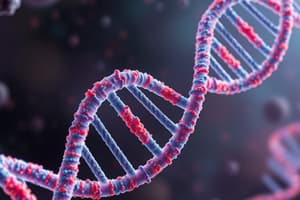Podcast
Questions and Answers
Which protein forms a short RNA primer on the template DNA during DNA replication?
Which protein forms a short RNA primer on the template DNA during DNA replication?
- DNA polymerase
- SSB
- Primase (correct)
- Helicase
What is the specific 9-mer sequence on the chromosome where DNA replication initiation begins?
What is the specific 9-mer sequence on the chromosome where DNA replication initiation begins?
- SSB binding site
- NHC protein binding site
- 13-mer sequence (correct)
- ATP-bound DNA sequence
Which domain of the DNA polymerase enzyme binds magnesium and zinc ions for catalysis?
Which domain of the DNA polymerase enzyme binds magnesium and zinc ions for catalysis?
- Finger domain
- Helicase domain
- Palm domain (correct)
- Thumb domain
What is the role of SSB during DNA replication?
What is the role of SSB during DNA replication?
Which enzyme is responsible for unwinding the DNA during DNA replication?
Which enzyme is responsible for unwinding the DNA during DNA replication?
What occurs within the 13-mer repeat sequence during the initiation of DNA replication?
What occurs within the 13-mer repeat sequence during the initiation of DNA replication?
What is the main function of the thumb domain in DNA replication?
What is the main function of the thumb domain in DNA replication?
In which direction is the lagging strand synthesized?
In which direction is the lagging strand synthesized?
What are formed when RNA primers are degraded by RNase enzyme during DNA replication?
What are formed when RNA primers are degraded by RNase enzyme during DNA replication?
What structure is formed at the termination of DNA replication?
What structure is formed at the termination of DNA replication?
How is DNA replication regulated in terms of methylation?
How is DNA replication regulated in terms of methylation?
What factor prevents reinitiation of DNA replication by binding to Hemimethylated regions?
What factor prevents reinitiation of DNA replication by binding to Hemimethylated regions?
Flashcards are hidden until you start studying
Study Notes
- The text discusses the process of DNA replication, which is divided into five parts: initiation, structure of DNA polymerase enzyme, elongation, termination, and control of energy application.
- In prokaryotes, DNA replication requires several proteins, including DNA polymerase, SSB, helicase, helicase loader, and primase.
- Initiation begins with DNA protein binding to the specific 9-mer sequence on the chromosome. Only ATP-bound DNA can bind, and strand separation occurs within the 13-mer repeat sequence.
- Helicase and helicase loader, NHC protein, and primase are loaded to the melted DNA using ATP energy. Helicase unwinds the DNA, and SSB quickly occupies the single-stranded DNA.
- Primase forms a short RNA primer on the template DNA, and DNA polymerase hollow enzyme is loaded for the synthesis of both the leading and lagging strands.
- The structure of DNA polymerase enzyme consists of a palm domain, finger domain, and thumb domain.
- The palm domain binds magnesium and zinc ions for catalysis, and the magnesium ions play an important role in the phosphodiester bond formation between the OH group and the incoming dNTP.
- The finger domain consists of an alpha helical protein and has arginine, lysine, and threonine residues at the active site, which bind to incoming nucleotides if base pairing forms.
- The thumb domain maintains the correct position of the RNA primer and the strong association of DNA polymerase with the substrate.
- Elongation occurs after DNA polymerase is loaded during initiation, and it involves the synthesis of the leading and lagging strands. The leading strand is synthesized continuously in the same direction of DNA polymerase enzyme, while the lagging strand is synthesized in the opposite direction.
- The synthesis of lagging strands involves the formation of RNA primers, which are extended by the polymerase to form loops. When RNA primers are degraded by RNase enzyme, short fragments known as Okazaki fragments are formed.
- Termination of DNA replication occurs at the Ter sequences present on the DNA, where DNA protein halts the replication fork and results in the formation of two circular chromosomes.
- DNA replication is regulated by the fact that only the Metallica strands undergo replication, and the newly synthesized strand is not methylated. This structure is known as Hemimethylated DNA.
- The SecA protein prevents reinitiation of replication by binding to the Hemimethylated regions, and DNA protein associates with ATP to bind to the DNA and initiate replication.
- DNA replication occurs only when there is a high nutrient supply for the generation of enough ATP for the DNA protein to be activated.
Studying That Suits You
Use AI to generate personalized quizzes and flashcards to suit your learning preferences.




